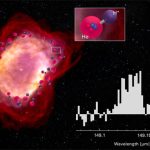Astronomers have just discovered a cosmic cannonball.
Key takeways
- Astronomers discovered a massive exoplanet, TOI-4603b, which is the size of Jupiter but has a mass nearly 13 times greater.
- TOI-4603b is over three times denser than Earth and nine times denser than Jupiter, making it one of the densest giant planets known.
- This exoplanet orbits its star in just 7.25 days, placing it in a rare group of close-in giant planets that challenge current planetary formation theories.
- TOI-4603b’s orbit is eccentric, suggesting it is still settling into its current position, possibly influenced by a nearby brown dwarf companion.
- Studying TOI-4603b can help scientists understand how massive planets and brown dwarfs form and migrate, providing valuable insights into their development.
An exoplanet the size of Jupiter circles a star 730 light-years away, yet its density is mind-boggling. Astronomers determined that the planet, known as TOI-4603b, had a mass of roughly 13 Jupiters.
That implies it’s over three times the density of Earth and slightly more than nine times the density of Jupiter. And it has a very short orbit around its star, lasting just 7.25 days.
This placed it in a tiny but substantial group of worlds that challenge our knowledge of planetary creation and development. This finding has been accepted for publication in Astronomy & Astrophysics Letters and is accessible on the preprint service arXiv.
“It is one of the most massive and densest transiting giant planets known to date,” write a team of astronomers led by Akanksha Khandelwal of the Physical Research Laboratory in India. “And a valuable addition to the population of less than five massive close-in giant planets in the high-mass planet and low-mass brown dwarf overlapping region that is further required for understanding the processes responsible for their formation.”
Theoretically, a planet’s mass is limited. That is because, above a certain critical limit, the temperature and pressure applied to the core are sufficient to initiate nuclear fusion, which is the process of smushing together atoms to form heavier elements.
For a star, the minimum mass at which this process begins is around 85 Jupiters; at this point, hydrogen atoms begin to fuse into helium.
The highest mass limit for a planet is considered to be between 10 and 13 Jupiters. Brown dwarfs are things that bridge the space between them. These do not have enough mass for hydrogen fusion; nonetheless, their cores may fuse deuterium, a heavy isotope of hydrogen that requires less heat and pressure.
Stars develop from the top down, when a dense cluster in a molecular cloud collapses under gravity to produce a protostar. The star then expands by sucking up material from the cloud surrounding it, which forms a disk.
The dust and gas left behind from this process produce planets, which begin from the bottom up when particles of debris adhere to one another, ultimately creating clusters that expand into planets themselves.
Brown dwarfs are hypothesized to emerge from a clump of molecular cloud that collapses due to gravity, similar to how stars do. They typically circle stars at a distance of at least five astronomical units (AU), which is five times the distance between Earth and the Sun.
Astronomers think that they grow in the same manner as stars do, collapsing from a clump of material in a cloud, and there is a spectacular “desert” of brown dwarfs in tight orbits.
TOI-4603b was discovered using data from NASA’s exoplanet-hunting satellite observatory TESS, which scans regions of the sky for weak, regular dips in brightness that indicate the existence of an orbiting exoplanet. The TESS results projected a world 1.042 times the radius of Jupiter that would orbit its star in slightly over a week.
The team followed up to get radial velocity readings. That is the amount by which an exoplanet’s gravity pushes its host star as they orbit a common center of gravity. If you know the mass of the star, you may calculate the mass of the exoplanet by calculating how much it moves around.
This is how the researchers determined that TOI-4603b had a mass 12.89 times that of Jupiter. Combining that with the object’s radius resulted in an average density of 14.1 grams per cubic centimeter. To put this into context, the Earth’s density is 5.51 grams per cubic centimeter. Jupiter has 1.33 grams per cubic centimeter. Lead has a density of 11.3 grams/cubic centimeter.
That is not unusual for a brown dwarf, which has an average radius of 0.83 times that of Jupiter; for example, a brown dwarf with a radius of 0.87 times that of Jupiter has a mass of around 61.6 Jupiters. These objects can get substantially denser than TOI-4603b.
TOI-4603b meets the majority of the requirements for being recognized as an exoplanet, and that is what Khandelwal and her colleagues have named it. However, because it is close to the brown dwarf mass limit, it may be an essential world for understanding how brown dwarfs and large planets arise and evolve in relation to their stars.
For example, the exoplanet’s orbit is noticeably oval, or eccentric, indicating that it is still settling into it. The star also has a brown dwarf companion orbiting at roughly 1.8 astronomical units, which may have gravitationally interacted with TOI-4603b. These hints indicate that the exoplanet is moving closer to the star from a more distant location.
HATS-70b, a planet with 12.9 times Jupiter’s mass and 1.384 times its radius, is less dense than TOI-4603b but still near to its star and displays signals of migration.
“Detection of such systems,” according to the investigators, “will offer us to gain valuable insights into the governing mechanisms of massive planets and improve our understanding of their dominant formation and migration mechanisms.”
The findings have been published in Astronomy & Astrophysics Letters and are available on arXiv.


